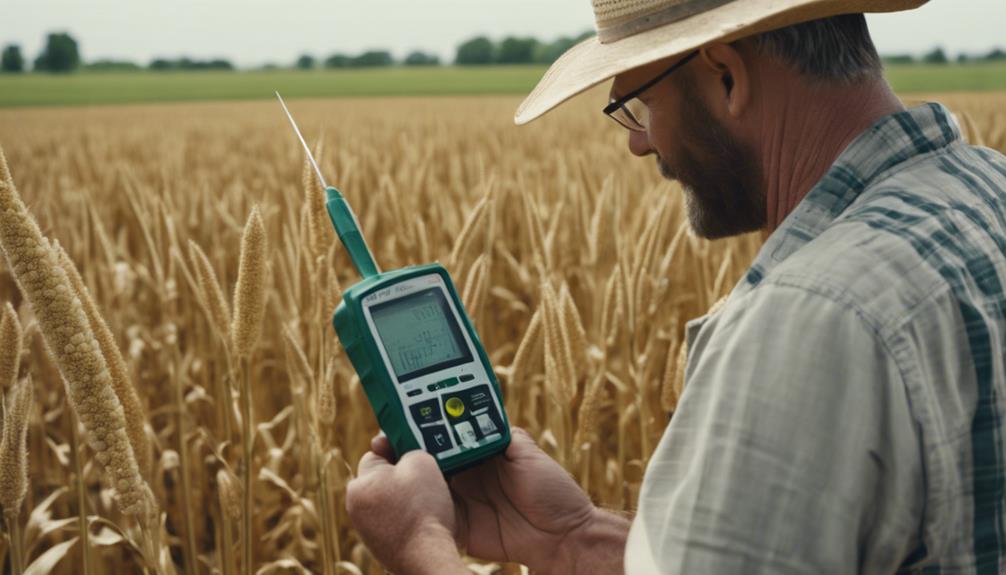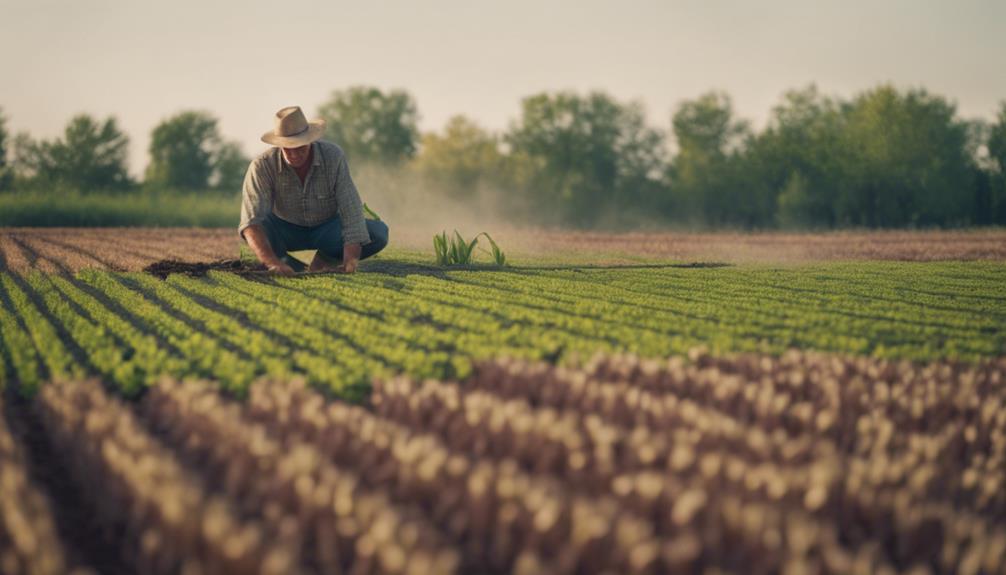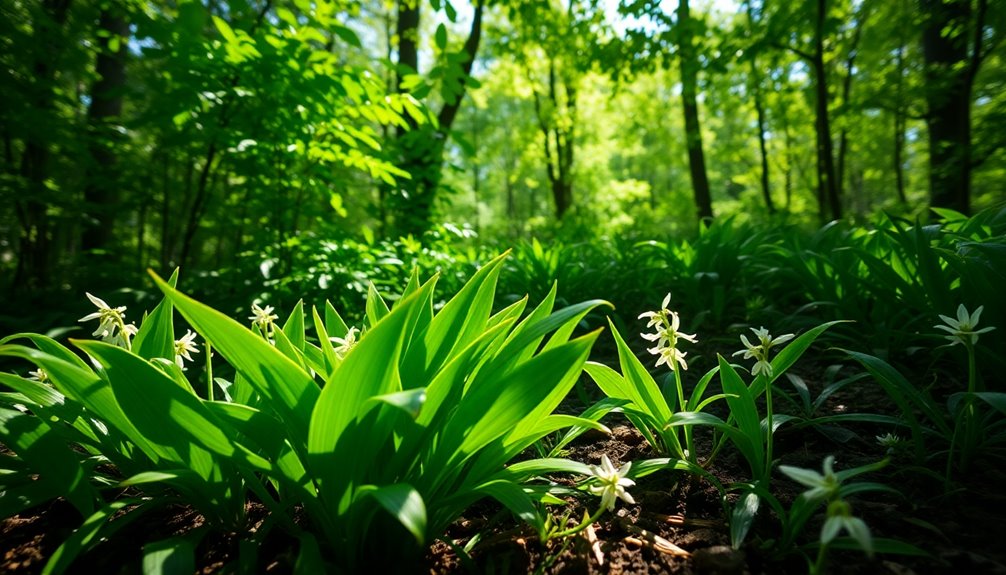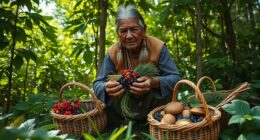In order to maximize the amount of forage sorghum harvested for your livestock, target the boot to early flowering stage for optimal quality and yield. Maintain stubble at 4 inches to promote regrowth and longevity. Harvest around 35 days after planting, with an 8-inch stubble to aid plant recovery. Aim for 50% NDF digestibility for dairy cows, and 35-40% for dry and beef cattle. Adjust your approach for better nutritional value, lower NDF levels for dairy cows, and harvest at the right moisture levels. Implement a 2-harvest system to enhance both yield and quality. By following these practices, you can ensure your livestock receive superior yields and top-notch nutrition, maximizing the benefits.
Key Takeaways
- Harvest at boot to early flowering for optimal quality and yield.
- Maintain a 4-inch stubble height for regrowth and stand longevity.
- Timing: Harvest around 35 days post-planting with 8-inch stubble.
- Aim for 50% NDFD for lactating dairy cows, adjust strategy for NDF levels.
- Utilize a 2-harvest system for improved yield and quality.
Optimal Maturity Stage for Harvesting
To maximize the quality and yield of forage sorghum, harvest at the boot to early flowering stage. This is the key maturity stage for ensuring maximum NDF digestibility, which is important for livestock diets.
By harvesting at this point, you guarantee that your forage sorghum maintains high-quality standards necessary for your livestock's health and nutrition. Delaying the harvest beyond this stage can result in reduced forage quality and palatability, particularly for dairy cows.
On the other hand, harvesting too early may lead to lower dry matter yield and nutrient content, impacting the overall nutritional value of the forage sorghum. It's essential to monitor the plant's development and maturity closely to pinpoint the ideal time for harvesting.
Stubble Height Considerations

Maintaining a 4-inch stubble height when harvesting forage sorghum is essential for promoting regrowth and enhancing stand longevity. This practice fosters nutrient cycling, leading to improved nutrient uptake in subsequent growth cycles.
By keeping the stubble height at 4 inches, you strike a balance between maximizing yield and preserving plant health. Opting for a shorter stubble height not only helps prevent soil compaction but also promotes better water infiltration, important for the sorghum's overall health.
Managing stubble height at 4 inches supports efficient regrowth, contributing greatly to the quality of forage available for your livestock's feed. Remember, the height at which you cut your forage sorghum plays an important role in its ability to bounce back and provide nutritious feed for your animals, so it's imperative to maintain this 4-inch stubble height for excellent results.
Timing of First Harvest

Timing the first harvest of forage sorghum is critical for maximizing yield and quality while ensuring ideal regrowth potential. To get the most out of your forage sorghum crop, follow these essential timing tips:
- Approximate Harvest Time: Aim to harvest forage sorghum around 35 days after planting. This timing allows for peak nutrient content and regrowth potential.
- Stubble Height Consideration: Maintain an 8-inch stubble height during the first harvest. This height promotes regrowth and helps the plant recover quickly.
- Impact on Yield and Quality: Harvesting too early can lead to lower yields and reduced forage quality. Conversely, delaying the harvest can result in lignification and decreased digestibility.
- Nutritional Value for Livestock: Proper timing of the first harvest is essential for maximizing the nutritional value of forage sorghum, ensuring your livestock receive high-quality feed.
NDF Digestibility Levels

Consider the NDF digestibility levels of forage sorghum to optimize livestock diets effectively.
NDF digestibility (NDFD) is a critical factor in ensuring high-quality nutrition for your animals. For lactating dairy cows, aim for NDFD levels around 50% to support their needs adequately.
In contrast, dry cows and beef cattle thrive on forage with NDFD levels between 35-40%.
Please be aware that the NDF levels in forage sorghum can restrict the amount fed to lactating dairy cows, impacting their overall diet quality.
To enhance NDF digestibility for dairy cows, selecting a BMR hybrid variety can extend the forage window and offer higher NDF digestibility levels.
Adjusting Harvesting Strategy

To optimize NDF digestibility essential for livestock diets, adjusting your harvesting strategy for forage sorghum is necessary. Follow these tips to make sure you get the most out of your forage sorghum crop:
- Harvest Timing: Choose the right time to harvest your forage sorghum to maximize NDF digestibility. This timing is vital for ensuring that your livestock receives the most nutritional benefit from the forage.
- Lower NDF Levels: Lower NDF levels in forage sorghum allow for increased forage amount for lactating dairy cows. Adjusting your harvesting strategy to achieve lower NDF levels can benefit your livestock's diet.
- Moisture Content: Harvest forage sorghum at the correct moisture content for silage or baleage production. This guarantees that the forage is preserved correctly and maintains its nutritional value.
- 2-Harvest System: Consider utilizing a 2-harvest system for forage sorghum to improve overall yield and quality. This strategy can help you achieve a better crop while maintaining its nutritional content for your livestock.
Enhancing Nutritional Value

Enhancing the nutritional value of forage sorghum is essential for optimizing livestock diets and maximizing overall productivity. To achieve this, focus on increasing NDF digestibility (NDFD) to at least 50%, especially important for dairy cows.
Consider utilizing BMR hybrid varieties to extend the forage window, enhancing forage quality for your livestock. Keep a close eye on NDF levels in forage sorghum to fine-tune intake and digestibility, particularly advantageous for lactating dairy cows.
Harvesting at the right maturity stage is paramount; it greatly impacts the nutritional value of forage sorghum in livestock diets. By properly managing harvesting practices, you can maximize the nutrient content and overall quality of forage sorghum for your livestock's consumption.
Importance of Smart Harvesting

Smart harvesting techniques are essential for optimizing the nutrient content and quality of forage sorghum intended for livestock feed. To guarantee you harvest maximum forage sorghum efficiently, consider the following key points:
- Harvest Timing Impact: Properly timing your harvest can greatly impact the forage yield and regrowth potential of your forage sorghum stands. Harvesting at the right time ensures you capture the peak nutrient content and quality for your livestock.
- Cutting Height Importance: Maintaining the ideal cutting height of 4 inches is vital for promoting ideal regrowth and stand longevity of forage sorghum. This practice helps the plants recover quickly and continue to provide nutritious feed for your livestock.
- Enhanced Milk Production: Effective harvest management practices not only benefit the forage sorghum but also contribute to higher milk production in dairy farming operations. Smart harvesting directly impacts the overall health and productivity of your livestock.
- Equipment and Adjustments: Using appropriate harvesting equipment and making necessary adjustments during the process are key factors in efficiently harvesting maximum forage sorghum for your livestock. Proper equipment and adjustments ensure you achieve the best results while maintaining the quality of the forage sorghum.
Frequently Asked Questions
How to Harvest Forage Sorghum?
To harvest forage sorghum effectively, cut at 35 days with an 8-inch stubble height. Consider a 2-harvest system for regrowth. Aim for 60-65% moisture for silage and 50-60% for baleage. Use a rotary cutter for tightly packed bales.
How Do Farmers Harvest Sorghum?
You harvest sorghum by cutting it at around 35 days with an 8-inch stubble height. Guarantee moisture levels are 60-65% for silage and 50-60% for baleage. Proper baleage packing is key to maintain quality and prevent spoilage.
What Are the Methods of Utilizing Sorghum as a Forage Crop?
To utilize sorghum as livestock forage, you'll need to focus on proper moisture levels for silage or baleage. It's like finding that sweet spot – not too dry, not too wet – to guarantee your animals get the best nutrition.
What Is the Best Forage Sorghum for Hay?
For the best forage sorghum hay, consider BMR hybrids with high NDF digestibility. Harvest at 4-inch stubble height to boost regrowth potential. Choose silage or baleage in summer for ideal moisture levels. Proper management maximizes yield, quality, and nutrients.
Conclusion
To sum up, optimizing forage sorghum for your livestock requires careful attention to maturity stage, stubble height, and harvesting timing.
By adjusting your harvesting strategy based on NDF digestibility levels and enhancing the nutritional value, you can guarantee your livestock receives the highest quality feed.
So, why settle for less when you can achieve maximum benefits with smart harvesting techniques?










